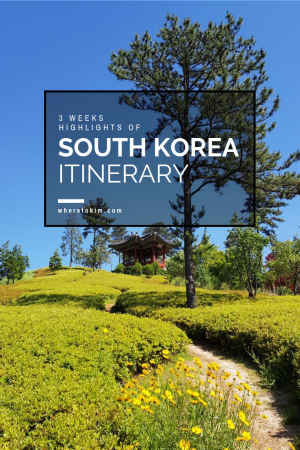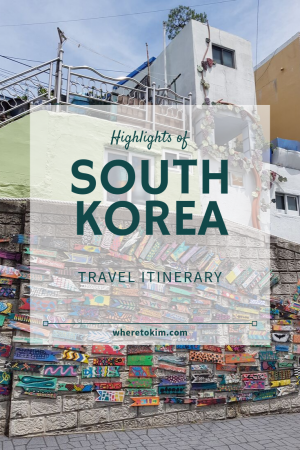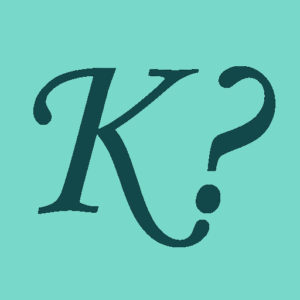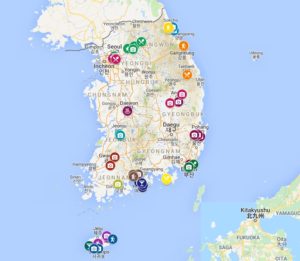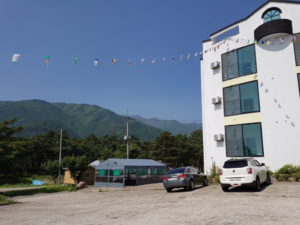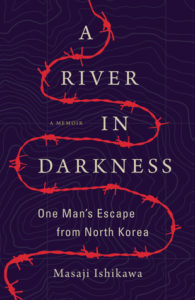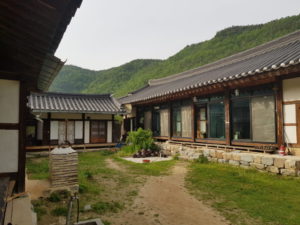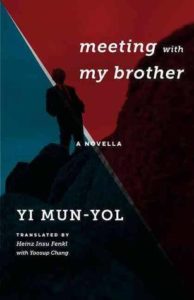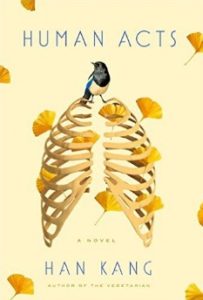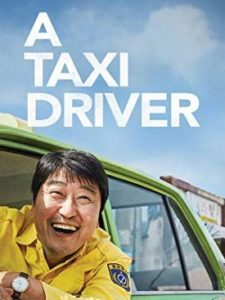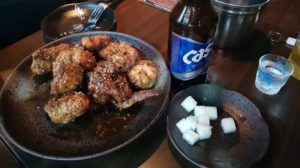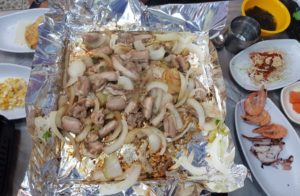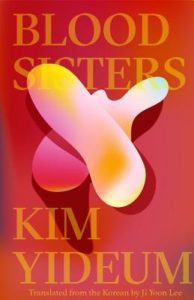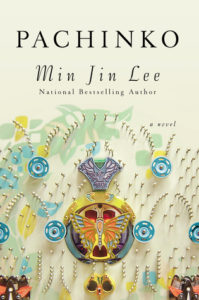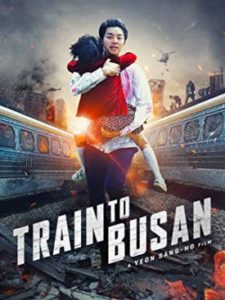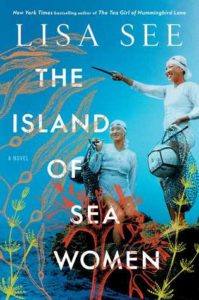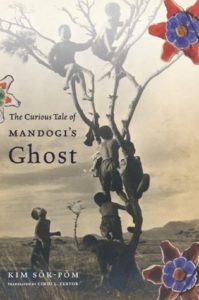Tour South Korea in three weeks by car and visit all the highlights with this travel itinerary. From Seoul, the capital of South Korea to Sokcho, Jeonju, Busan and Jeju. If you are looking for a well-balanced mix of big cities, culture and nature, then this travel itinerary is for you.
Travel itinerary overview
- Seoul – day 1 – 3
- Sokcho – day 4 – 6
- Andong – day 7 – 8
- Jeonju – day 9 – 11
- Gwangyang – day 12 – 15 (you can also stay in Suncheon or Boseong)
- Busan – day 16 – 18
- Jeju – day 19 – 21
- Practical information
Use this itinerary if you want a comfortable trip. It’s not a quick see-it-all, but a well-balanced itinerary using one city as a base for exploring the area.
Have you seen all the above already? Then check out my lesser-known south and west of South Korea itinerary for second or third time visitors.
Click here to see the map for this three weeks South Korea itinerary in Google maps.
Seoul day 1 - 3
Day 1 - Myeongdong and Seoul Tower
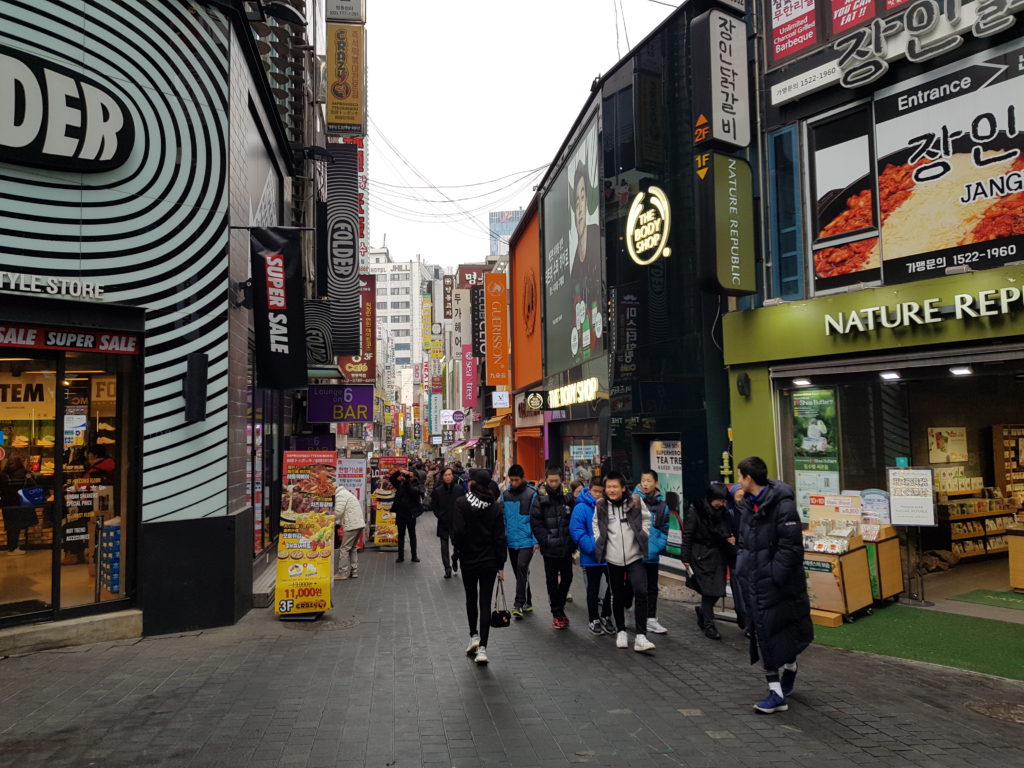
Your first day in Seoul, the capital of South Korea. Be prepared to visit the diverse neighborhoods: go shopping, try out the food, admiring the architecture.
After arriving, buy a public transport card and load it with 60.000 Won and head towards the bus station to catch a bus 6701 to City Hall. For first time visitors, the area around City Hall is the perfect starting point to go sightseeing in Seoul: two well-connected subway lines nearby and the Seoul train station within walking distance. At night you can walk to the vibrant area of Myeongdong for entertainment.
If you arrive early, visit Lotte Department store and browse the stores and supermarket.
Spend the afternoon wandering about Myeongdong, a popular shopping destination for cosmetics and clothes. This area is busy all day but comes to life at night.
When it gets dark take the cable car up to Namsan Tower for a nice view over the city. Afterward, head back to the street food stalls in Myeongdong to eat your first tteokbokki of your trip. The start of the cable car is within walking distance from Myeongdong. While walking you can see the lights playing with Shinsegae and Lotte Department Store. The Bank of Korea (opposite of Shinsegae) is also an interesting building to see; its ‘western’ architecture not quite matching the modern buildings surrounding it.
Day 2 - Gyeongbokgung Palace, Bukchon Hanok Village, Insadong, Cheonggyecheon stream
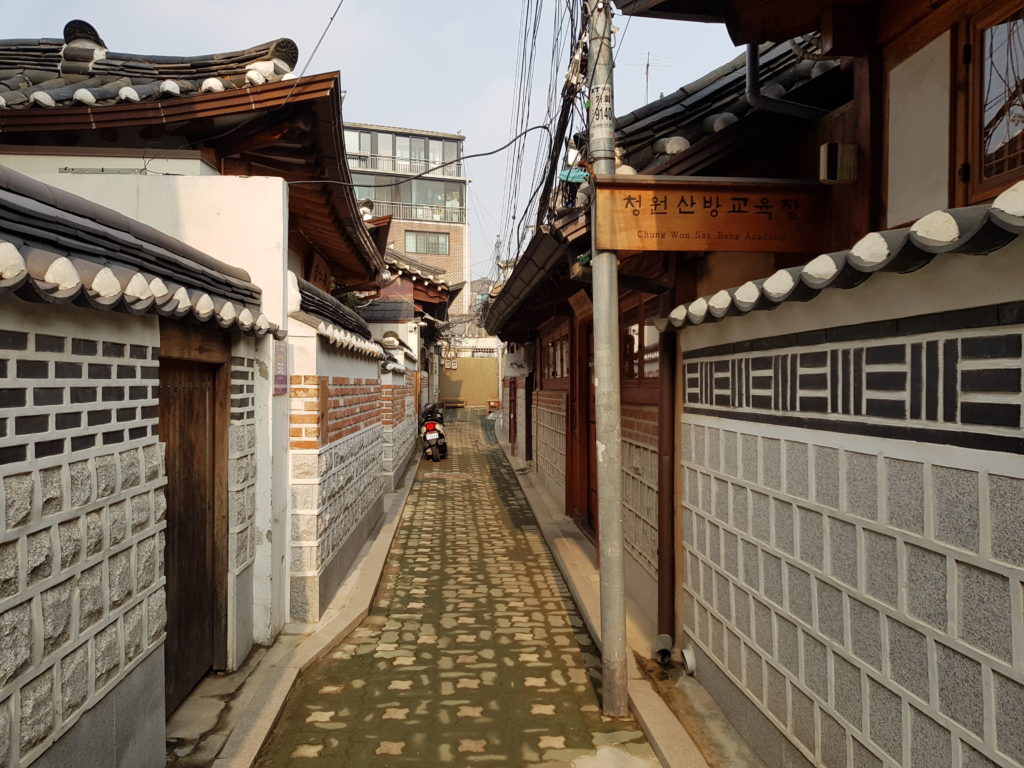
Tip for eating Korean food in South Korea
Many restaurants don’t open before 11 am. At least not the ones you can find information about online. But there are many small family-owned establishments that open early and you can see many locals wandering in.
Check my Search for breakfast in South Korea post for more tips.
On the road between City Hall and Gyeongbokgung Palace you can see the statue of King Sejong, the inventor of South Korean’s Hangul script. Follow the boulevard to Gyeongbokgung Palace. Admire the view of the old palace and take a walk on the palace grounds. Keep walking until you find yourself straight ahead until you reach the far end of the palace grounds. You will find yourself alone with ample photo opportunities. If you go to the North exit you can see the Blue House.
Turn back into the park and take the east exit towards Bukchon Hanok village. Wander around the small streets and visit a tea house for a traditional tea with snacks to show off your tea-making skills.
From there head towards Insadong; it’s all within walking distance. Visit the craft stores and Ssamziegil mall. If you’re up for some more tea you can go to Osulloc: a modern tea house.
For dinner tonight head towards the area in between Insadong and Chyeonggyecheon stream. This area looks best at night when all the billboards are lighting up the area. Try your hand at grilling your own meat.
Take a stroll along Chyeonggyecheon stream and turn right near Ganghwamun subway station to visit Kyobo Gwanghwamun Bookstore (open until 10 pm). Find out more about the most popular Korean books.
Day 3 - Noryangjin fish market and Gangnam
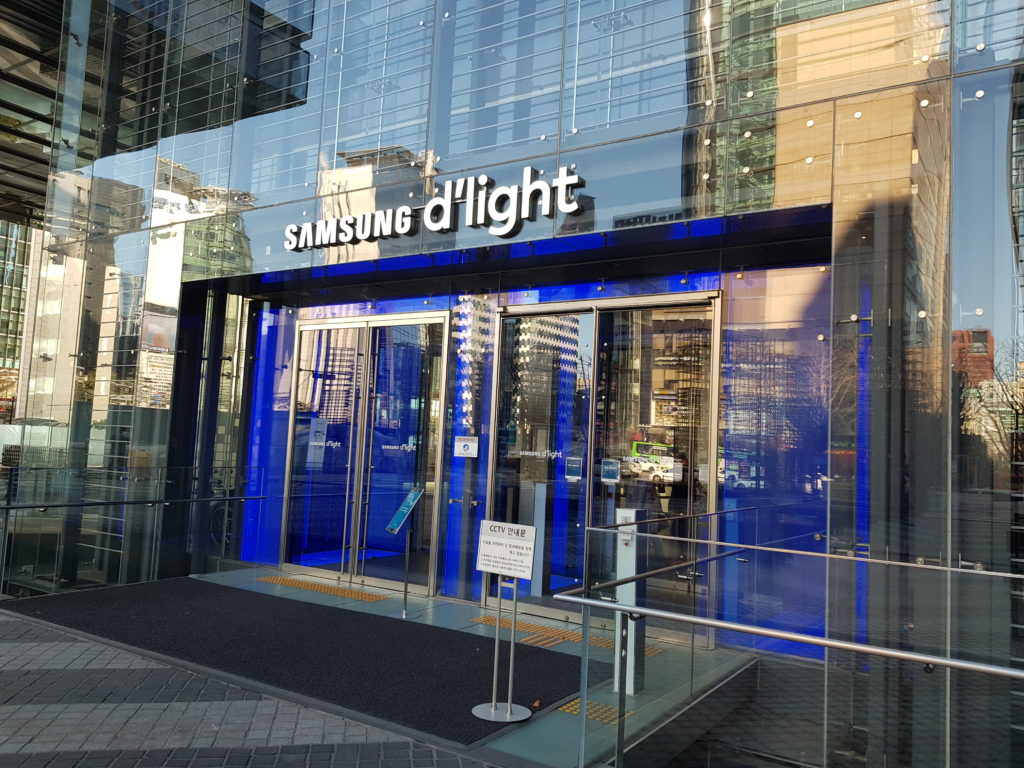
Take the subway to Noryangjin fish market for breakfast. Buy the fish you want to eat for breakfast and head to one of the restaurants with your bought fish to have it prepared for you.
Head to Samsung D’light and do the interactive tour to admire Samsung’s innovations. From there go to Apgujeong-ro in Gangnam for a walk along K-Star road and many luxury stores. From here walk to Garosu-gil (the ‘tree-lined street’) for a drink at Eighty seconds or if you want something less touristy, head to the area around Bongeunsa-ro 2 gil in Yeoksam-dong; my favorite restaurant and cafe area in Gangnam.
Where to stay in Seoul
Seoul has many hotels. You can stay in any of the neighborhoods and explore the city from there. When depending on public transport I always look for hotels situated near important subway stations or bus hubs so I can explore the whole city with ease.
For first time visitors, I recommend staying near City Hall, as it has two important subway lines nearby and Seoul Train Station is within walking distance. At night you can explore the vibrant area of Myeongdong for entertainment.
My recommendation is Travelodge Myeongdong City Hall: a very good location near City Hall, not expensive and clean and big enough rooms. There is a spa in the hotel, but it is for men only. I stayed in this hotel for one week over Christmas and I would stay here again if I was looking for a hotel near City Hall.
For my second visit, I stayed in Gangnam to experience another neighborhood. I chose to stay in Gangnam this time because it is in the southeastern part of the city and I wanted to drive east after picking up my rental car. Plus I was looking for a hotel within walking distance from one of the car rental offices for easy pick-up.
If you want to stay in Gangnam I recommend Best Western Premier Hotel Gangnam. It is at a walking distance from two useful subway lines connecting you to the northern part of the city: Sinnonhyeon subway station (also a very useful bus hub) and Gangnam subway station, which makes it a very good starting location for exploring the city. The hotel service is good, the rooms are big enough and affordable.
What to read when visiting Seoul
See my Best Korean books to read before your visit to South Korea post to find out about the most popular Korean books.
More things to do in Seoul?
- In my 11 Ways to Spend Your Day in Seoul you can find many more things to do in and around Seoul.
- 5 Best Cafes with a Mountain View in Seoul
- Visit Daelim Museum in Seoul
- Christmas and Christmas concerts in Seoul
- Visit the Korean DMZ
Sokcho - day 4 - 6
Day 4 - Seoul to Sokcho - Garden of Morning Calm and Nami Island
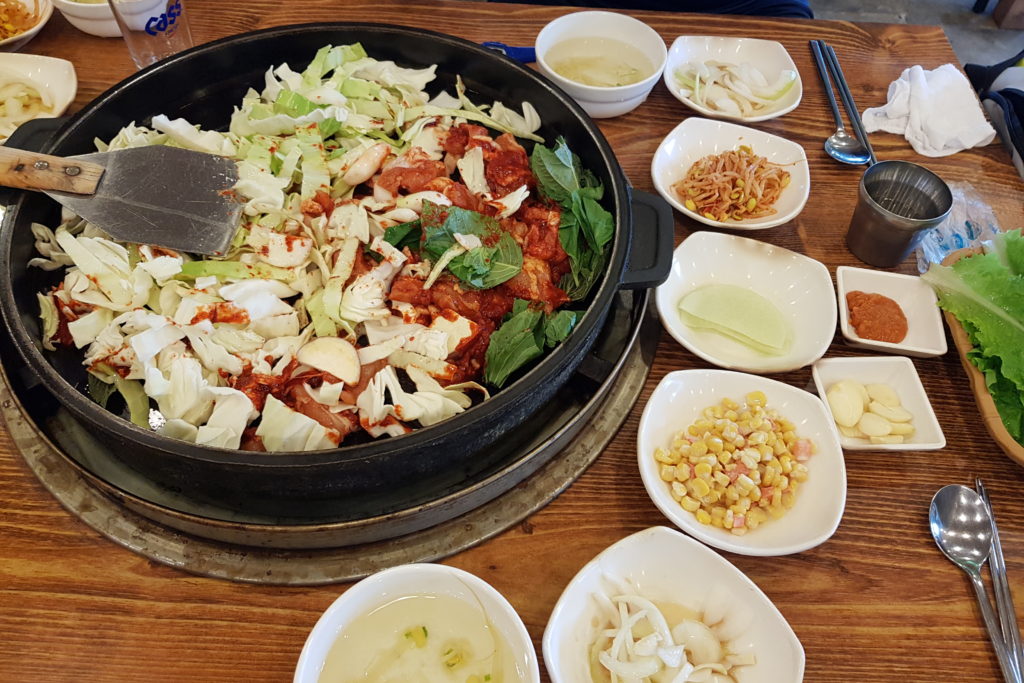
Pick up your rental car in the morning. Visit the Garden of Morning Calm and see the blooming flowers in spring or summer, autumn leaves in fall or snowy landscape in winter. If you’re visiting in winter it’s worth going there at night as a day trip from Seoul as the whole garden will be lighted and look like a winter wonderland.
From there, head to the ferry starting point for Nami Island and take a stroll along the tree-lined boulevard famous from the Korean TV Drama Winter Sonata.
If you have time left go to Chuncheon to try Chuncheon Dakgalbi or visit Gubongsan Mountain Observatory. If not head straight to Sokcho from here.
Day 5 - Sokcho Tourist Market, Abai Village, Naksansa Temple
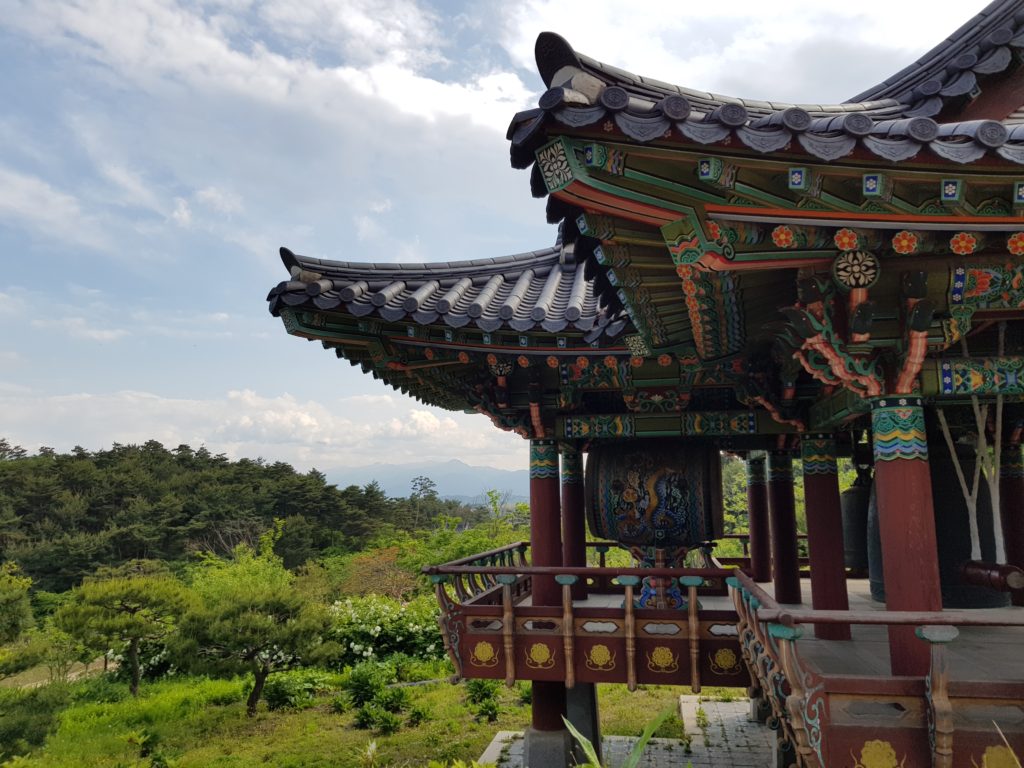
Head to Sokcho Tourist and Fishery Market for breakfast. Score some fresh sashimi or try numerous other snacks or meals in one of the stalls. If you’re wondering why half of the people you see are carrying flat boxes (sometimes six of them), head over to Mansuk Dak Gangjeong chicken stall and try their fried chicken (recommended!).
Take a short drive to Abai Village; a small village of North Korean expats. You can take the boat, but also drive over the bridge and park on the island itself. The village is small, but there is a lovely beach at the end with a nice view over Sokcho with the mountains in the backdrop. While you’re there try Abai Sundae, blood sausage with squid casing and filling
Follow the coast further south to visit Naksansa temple grounds, featuring many small buildings and temples, statues and a giant Stone Buddha.
Day 6 - Seoraksan National Park
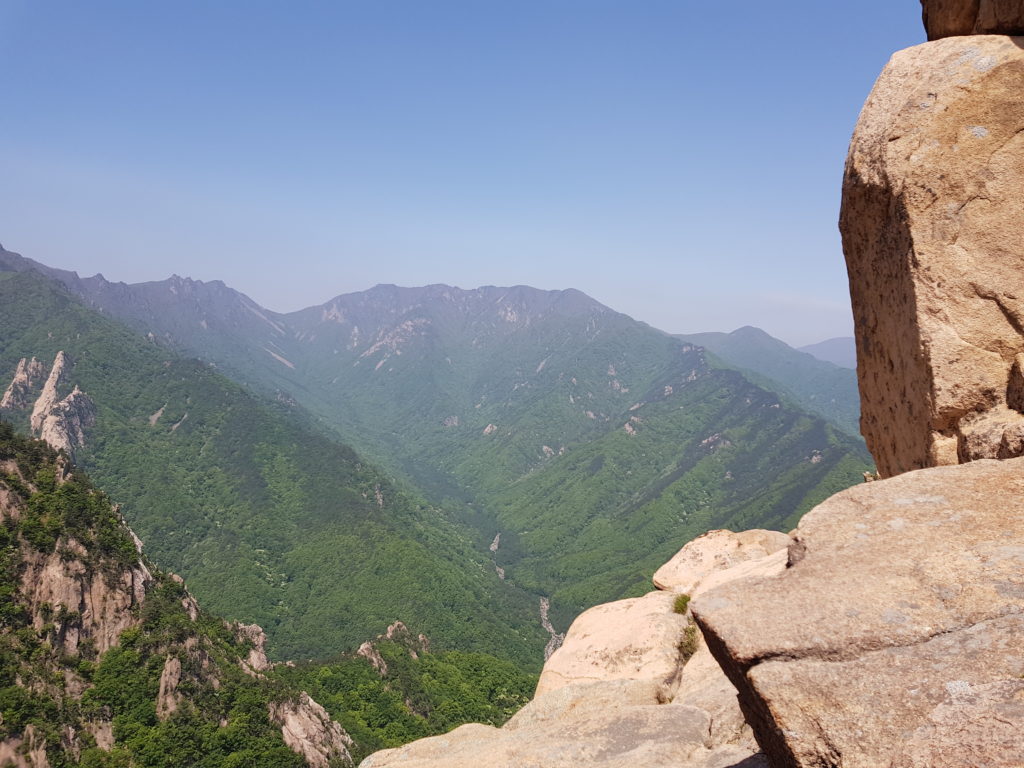
Sokcho is famous as one of the gateways for exploring Seoraksan National Park. (And among a niche group: the first city in South Korea where you could play Pokemon Go).
Go for a hike to Ulsanbawi peak, Biryong Waterfall, Geumganggul Cave, Biseondae or one of the other routes. It is also possible to take a cable car to Gwongeumseong Fortress and take the stairs (10 minutes) to the top and admire the breathtaking view.
Where to stay in Sokcho
I recommend Seorak Pension. This pension is located in a quiet area between Sokcho and Seoraksan National Park. The Japanese rooms are quite big and clean and the owners are very friendly. When I was staying there they brought over Korean tea and iced tea when they saw me reading a book in the BBQ and picnic area next to the hotel. If you travel by car, you can park it right next to the pension. If you’re using public transport you’re probably better off nearer to the city center of Sokcho.
What to read in Sokcho
From Sokcho you can reach the Goseong Unification Observatory near the border with North Korea within an hour and Abai Village also has a link with North Korean expats. So my reading recommendation for this part of the trip is:
Masaji Ishikawa - A River of Darkness: One Man’s Escape from North Korea
About the treatment of someone stuck between two worlds. It makes you want to fix the world, but just like the main character, you probably won’t be able to do anything about it.
Half-Korean, half-Japanese, Masaji Ishikawa has spent his whole life feeling like a man without a country. This feeling only deepened when his family moved from Japan to North Korea when Ishikawa was just thirteen years old, and unwittingly became members of the lowest social caste. His father, himself a Korean national, was lured to the new Communist country by promises of abundant work, education for his children, and a higher station in society. But the reality of their new life was far from utopian.
Interested? You can get your copy from Amazon.
Where to eat in Sokcho
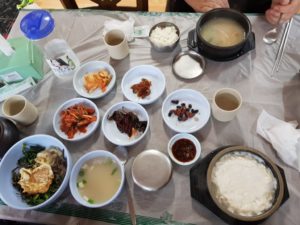
The restaurant next to Seorak Pension: 고향민속마을 serves a good Sundubu (soft tofu soup) and also has good reviews in KakaoMap. I can also recommend their bibimbap with mountain vegetables.
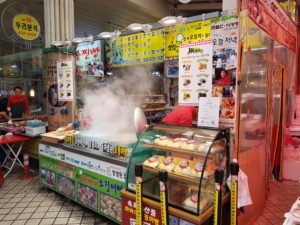
Sashimi, fried chicken or snacks at Sokcho Tourist and Fishery Market.
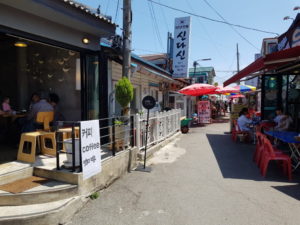
Try Abai Sundae (blood sausage with squid casing and filling) in Abai Village.
Andong - Day 7 - 8
Day 7 - Sokcho to Andong - Gangneung and Taebaek
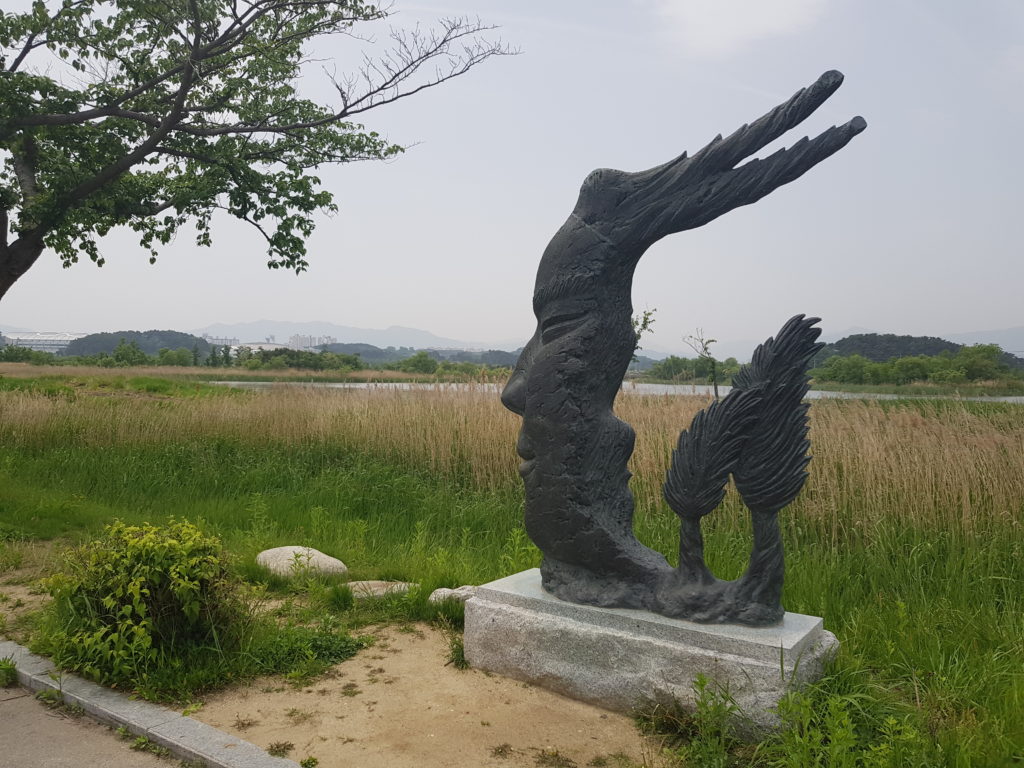
Head to Gangneung to visit the Olympic Stadium used for the 2018 Winter Olympics. Afterward, take a stroll in Gyeongpo Provincial Park; a small wetland reserve with interesting sculptures. If you’re lucky the lotus pond is filled with lotus flowers again; in May 2018 it was one big mud pool.
From there on take the mountain road enjoying the scenery and stop in Taebaek for lunch. After lunch continue onwards to Andong.
Where to eat in Taebaek
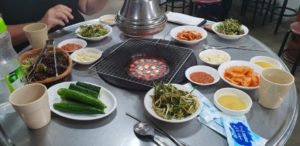
Day 8 - Dosanseowon Confucian Academy, Hahoe Folk Village
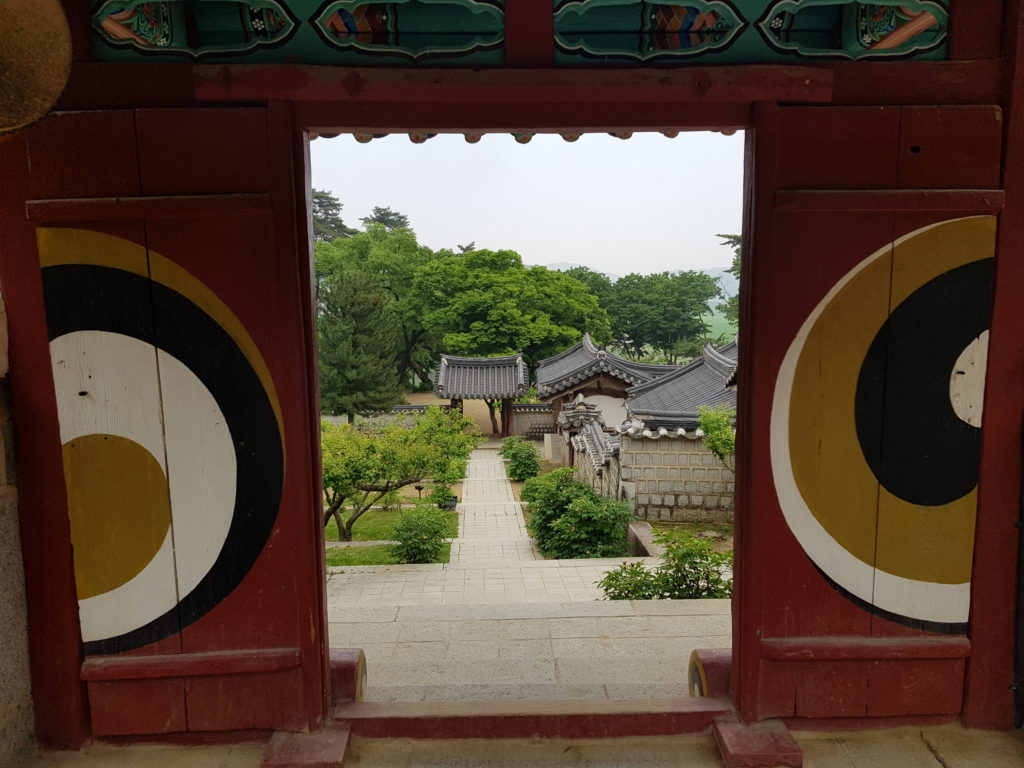
Today will be all about culture and history. In the morning drive north to Dosanseowon Confucian Academy, the intellectual home of Korean Confucianism established in 1574. Not only are the buildings quite a sight to see, but the surrounding area is also beautiful. It is easy to imagine studying in peace at such a location.
Head over to the west of Andong to visit Hahoe Folk Village, a well kept open-air museum and have lunch at a traditional restaurant. Explore the traditional houses in the village and try some of the Soju brewed there. Other food tips: Heotjesabap (a type of Bibimbap eaten by the nobles), Andong Gangodeungeo (salted mackerel), and Andong Guksu (a kind of noodle dish).
Where to stay in Andong
For Andong, I just had to choose a traditional house for a hotel. I stayed in Nongamjongtaek, a building complex (originally a noble’s house) that has been passed on for generations from eldest son to eldest son. There are smaller rooms connected to the main house, but you can also end up with your own private building with a porch as I did. It’s situated at a beautiful historical location with a stream surrounded by mountains. The hosts were very friendly and caring. Traditional Korean breakfast is included (very good with many side dishes) and the lady of the house brought over home-made snacks in the evening. This is not a cheap hotel to stay at but for me, the experience was totally worth it (and you can compensate it with cheaper hotels/motels in other cities).
What to read in Andong
This book isn’t set in the Andong area (more in Seoul and China), but the main character partly grew up in the Andong area and uses Andong soju for commemoration service.
Yi Mun-Yol - Meeting with my brother
Narrated by a middle-aged South Korean professor, also named Yi, whose father abandoned his family and defected to the North at the outbreak of the Korean War. Many years later, despite having spent most of his life under a cloud of suspicion as the son of a traitor, Yi is prepared to reunite with his father. Yet before a rendezvous on the Chinese border can be arranged, his father dies. Yi then learns for the first time that he has a half-brother, whom he chooses to meet instead. As the two confront their shared legacy, their encounter takes a surprising turn.
Meeting with My Brother represents the political and psychological complexity of Koreans on both sides of the border, offering a complex yet poignant perspective on the divisions between the two countries. Through a series of charged conversations, Yi explores the nuances of reunification, both political and personal. This semi autobiographical account draws on Yi’s own experience of growing up with an absent father who defected to the North and the stigma of family disloyalty.
Interested? Get your copy from Amazon.
Jeonju - day 9 - 11
Day 9 - Andong to Jeonju - Andong pagoda and hot spring footbath in Daejeon
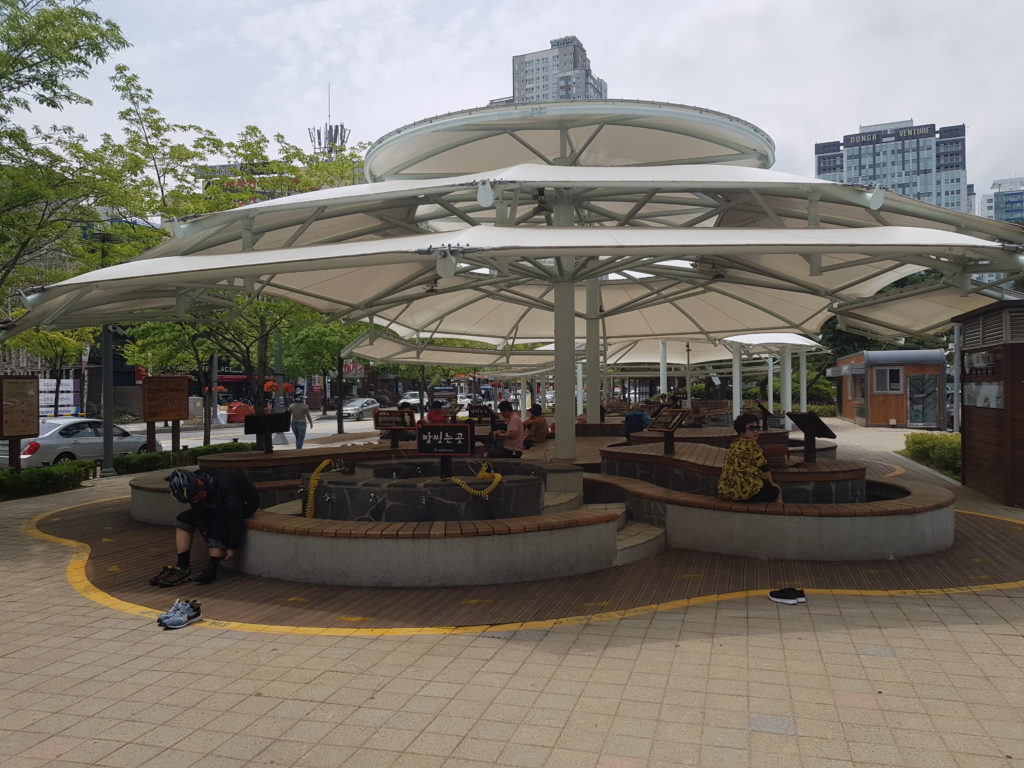
On the right side of Andong, you can find a sole surviving stone pagoda next to train tracks. Even though the pagoda on its own is not very impressive, with the traditional building behind it it’s quite photogenic. The main attraction here is to observe how modern buildings and facilities were built around it in not a very pretty way.
Take the highway and head over to Daejeon. If you have time you can park around Jungangno to go shopping. Otherwise, go straight to the Yuseong Spa area for a relaxing and free open-air footbath with hot spring water before you go on to Jeonju.
Day 10 - Jiff Film street, Jeonju Hanok Village
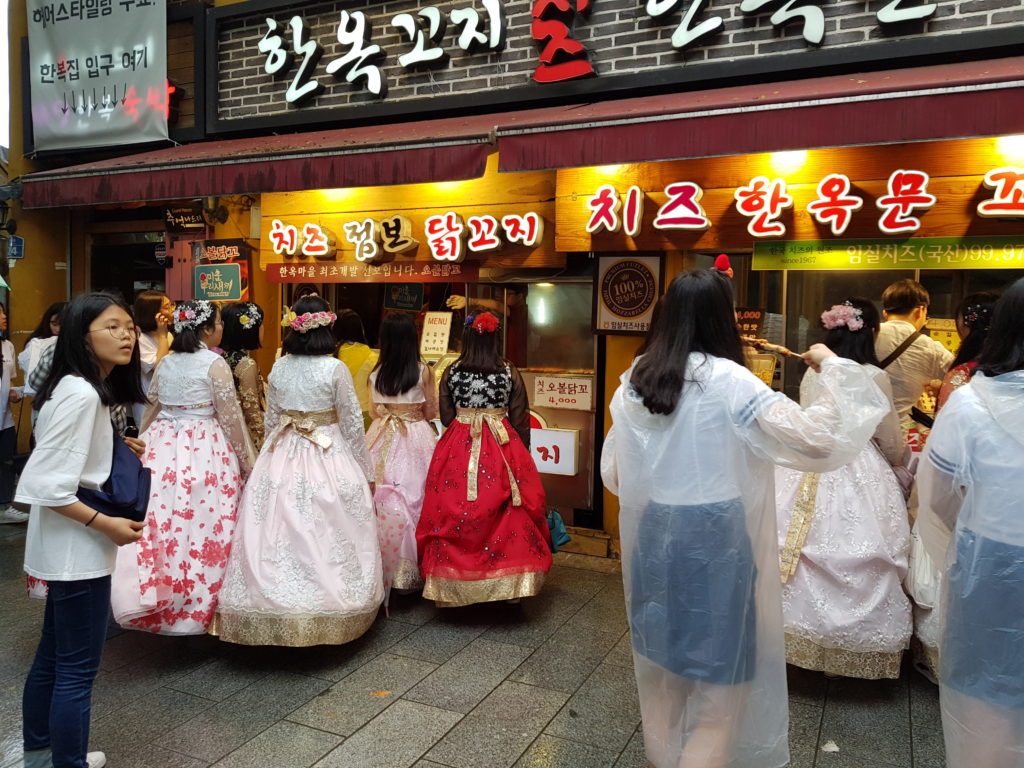
Go shopping in the area around Jeonjugaeksa 5-gil and head south towards Pungnammun Gate.
From there go east and you walk right into Jeonju Hanok Village. Admire the art, the crafts and the buildings. Take pictures with other visitors in Hanbok, Korean traditional clothing or try one on yourself. Rest and drink tea in one of the traditional houses.
Jeonju is famous for its food culture: especially Jeonju Bibimbap (with raw beef tartare) and tteokgalbi (grilled beef patties). At night the area with streetfood stalls really comes to life, so if you’re feeling adventurous (don’t worry, it’s safe) try some grilled cheese, octopus or chicken skewers, Moju, strawberry rice cake or drink infusions.
Day 11 - Deokjinho lake, Jaman Mural Village, Gyeonggijeon Shrine
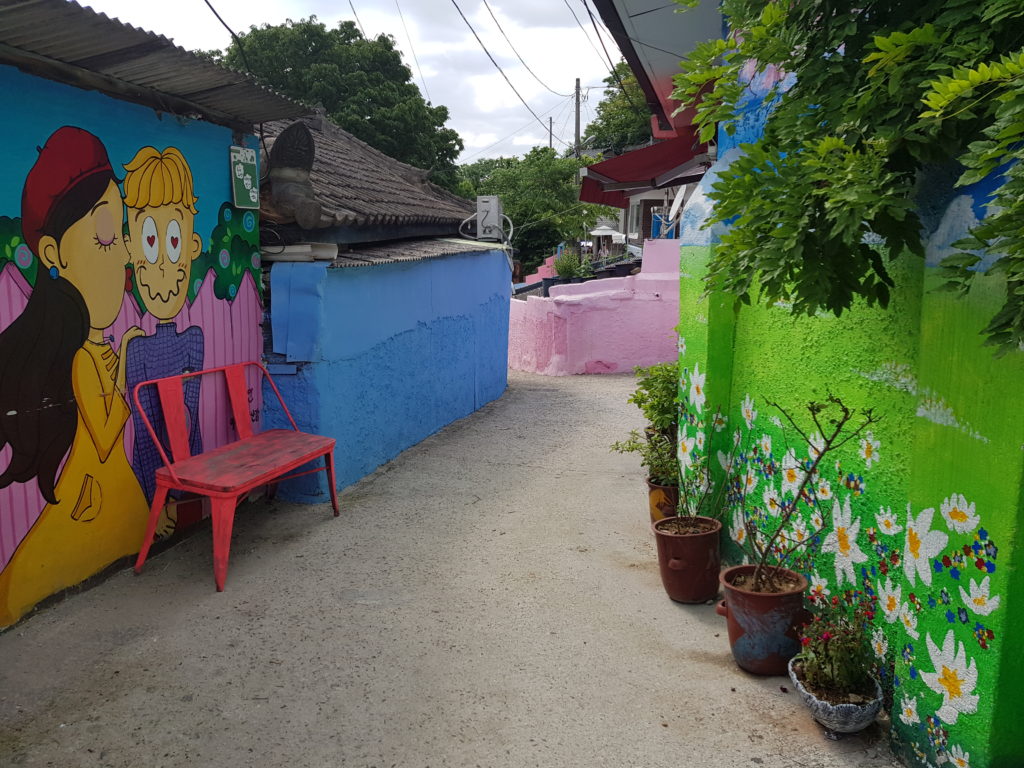
Visit Deokjinho lake and park in the morning and take a stroll around Myeonnyun 4-gil, a street that is very much alive with university students.
Afterward, head to Jaman Mural Village to watch the beautiful murals and take pictures of the view over Jeonju Hanok Village. Try some Bingsu (shaved ice cream) while enjoying the view. For dinner, you can easily walk over to Hanok Village.
Where to stay in Jeonju
There are many good places to stay in Jeonju. I chose White Tourist Hotel because the rooms were spacious, it had a hotel parking lot and it was situated in a quiet area. You can also stay in Jeonju Hanok Village, but as I had just spent two days in a traditional house in Andong, I preferred a bed over the floor. From this hotel, you can walk to Deokjinho lake (via Myeonnyun 4-gil) and back and take the car or bus to Jeonju Hanok village and Jaman Mural Village. I also found a really nice café and a good Jeonju Bibimbap restaurant near the hotel.
What to eat and drink in Jeonju
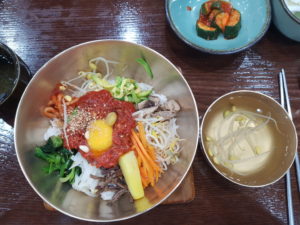
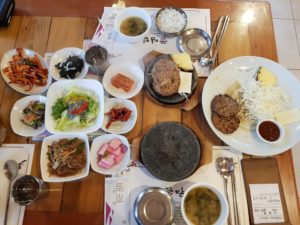
Jeonju beef patties: all over Jeonju Hanok Village you’ll see restaurants offering beef burgers of seasoned meat, often served with pineapple and grilled cheese.
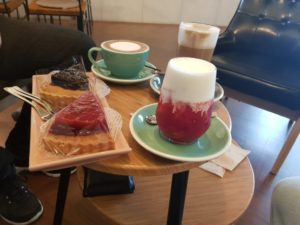
Snowing cafe (스노잉카페 본점): I really enjoyed this cafe. The drinks look pretty and the cafe interior looks nice. Visit this cafe to try some ice topped tea or coffee.
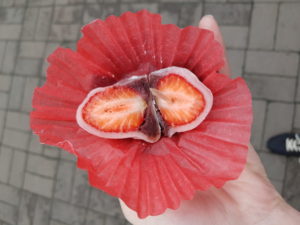
Jeonju street food: try grilled cheese, chicken or octopus on a stick, strawberry rice cake and many more snacks.
Gwangyang - day 12 - 15 (you can also stay in Suncheon or Boseong)
Day 12 - Jeonju to Gwangyang - Damyang Bamboo Forest and Gwangju Student Uprising monument
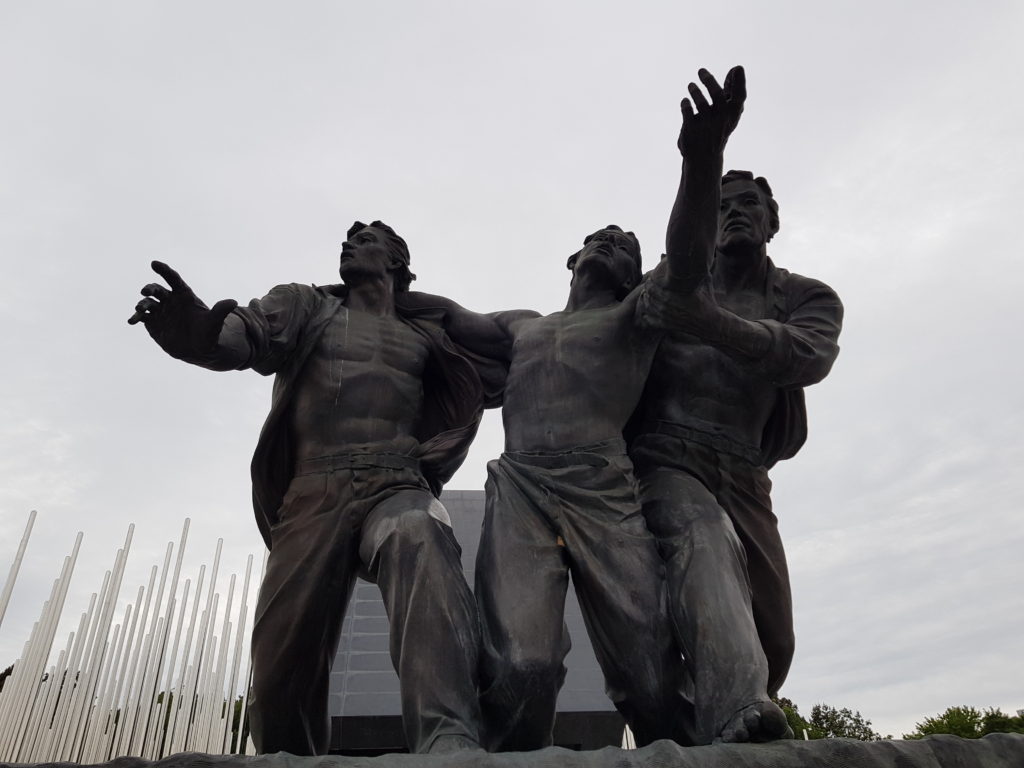
From Jeonju drive over to Damyang to visit Juknokwon bamboo forest to take a walk with the bamboo shoots towering over you. The forest can be quite crowded near the entrance, but as you follow the path it becomes quieter. There is also a garden within the complex where you can relax.
Your next stop is the Gwangju monument of the Student Uprising of May 18, 1980, when many students took up arms to protest against the martial law government. The sculptures are in the middle of a small park and show the desperation the people involved must have felt very well. If you’re interested to know more about what happened during the uprising, please check out the book and movie recommendation below.
You can then head over to your hotel in the Gwangyang, Suncheon and Boseong area.
What to read and watch before Gwangju
Han Kang’s Human Acts gives a close account of the killing that took place during the Student Uprising. It’s written from a student’s point of view and simply a must-read when you plan to visit Gwangju.
I don’t usually recommend movies, but for Gwangju, I’d recommend A Taxi Driver.
Han Kang - Human Acts
In the midst of a violent student uprising in South Korea, a young boy named Dong-ho is shockingly killed.
The story of this tragic episode unfolds in a sequence of interconnected chapters as the victims and the bereaved encounter suppression, denial, and the echoing agony of the massacre. From Dong-ho’s best friend who meets his own fateful end; to an editor struggling against censorship; to a prisoner and a factory worker, each suffering from traumatic memories; and to Dong-ho’s own grief-stricken mother; and through their collective heartbreak and acts of hope is the tale of a brutalized people in search of a voice.
Interested? Get your copy from Amazon.
A Taxi Driver
A Taxi Driver is a very good movie, based on a true story, about a taxi driver from Seoul who does what he can to help a foreign photographer documenting what happened to the people involved in the uprising.
Interested? Watch it on Amazon Prime.
Day 13 - Boseong tea fields, Suncheon Drama Film set
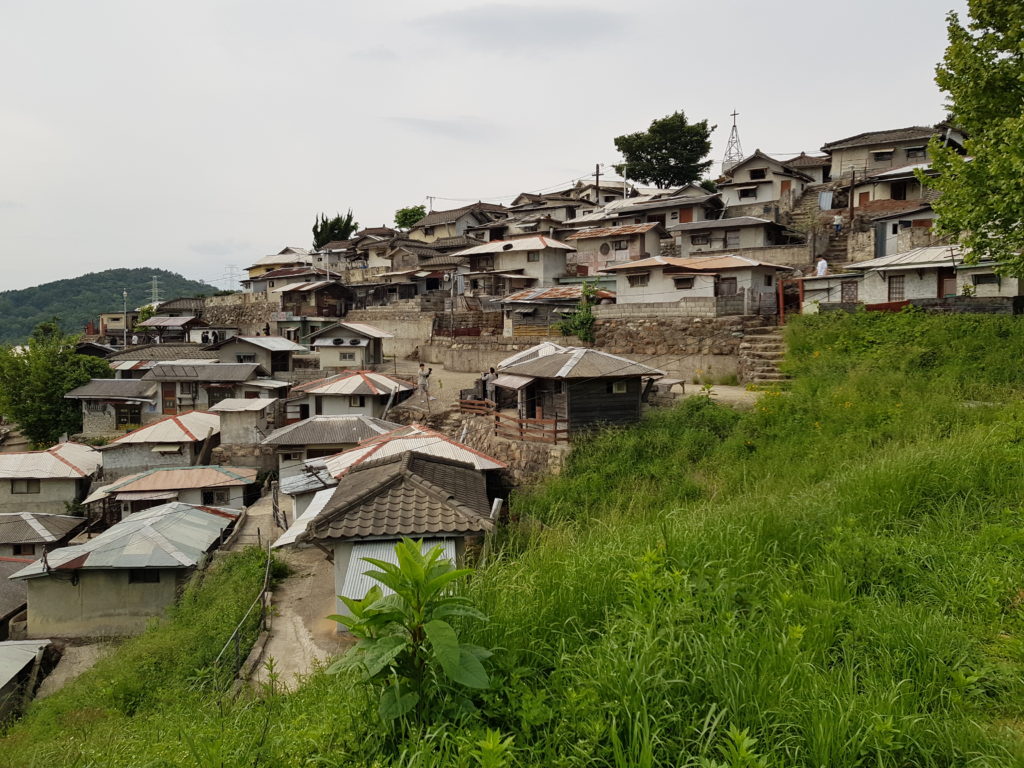
Drive over to Boseong tea fields in the morning. If you’re visiting in May, see if you can plan your visit around the annual tea festival. You can walk around the tea fields and even go up for a very nice view of the surrounding area. Don’t forget to sample and buy some tea at the tea museum/store.
If today happens to be the weekday the big Suncheon outdoor market is open (every five days), head over to the market for some snacks. If not, go straight to the Suncheon Drama Film set to walk around reconstructed ‘50’s and ‘70’s streets. You can completely immerse yourself in the film set, but this is also a good opportunity to get both the old way of living and the new way (tall buildings) in one picture.
Day 14 - Yeosu and Dolsando
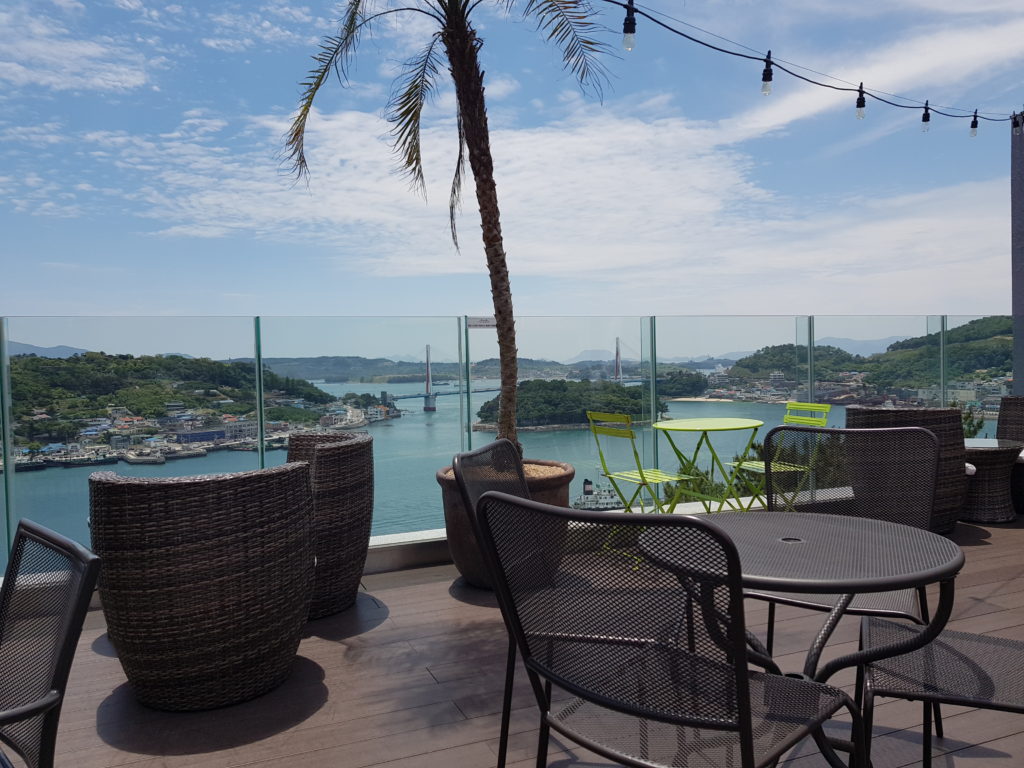
Go east of Gwangyang and take the long Yi Sun-sin suspension bridge to get a good view of the industrial harbor. The top part of Yeosu is filled with industry. But as you continue southwards you leave the industrial complex behind.
Stop in Yeosu city to have a drink or lunch in a cafe. There are some really nice areas giving you a good view of the harbor and the rooftops.
After a short break, go for a drive around Dolsando to admire the bays, the fishing villages and the land.
Read more: A day trip to Goheung peninsula
Where to eat and drink in Yeosu
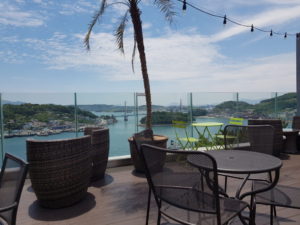
In Yeosu you can find many cafes where you can have a drink and relax while taking in the beautiful view of the city. I went to the Rooftop Cafe (낭만카페) and can recommend it for anyone looking for a stop before you continue your road trip around Yeosu and Dolsando.
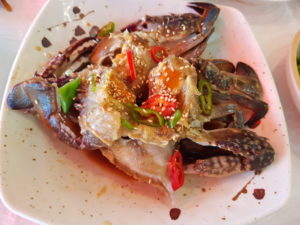
Various crab dishes like marinated raw blue crab at Naraebabsang.
Day 15 - Gubongsan Observatory and Suncheon Bay National Garden and Wetland Reserve
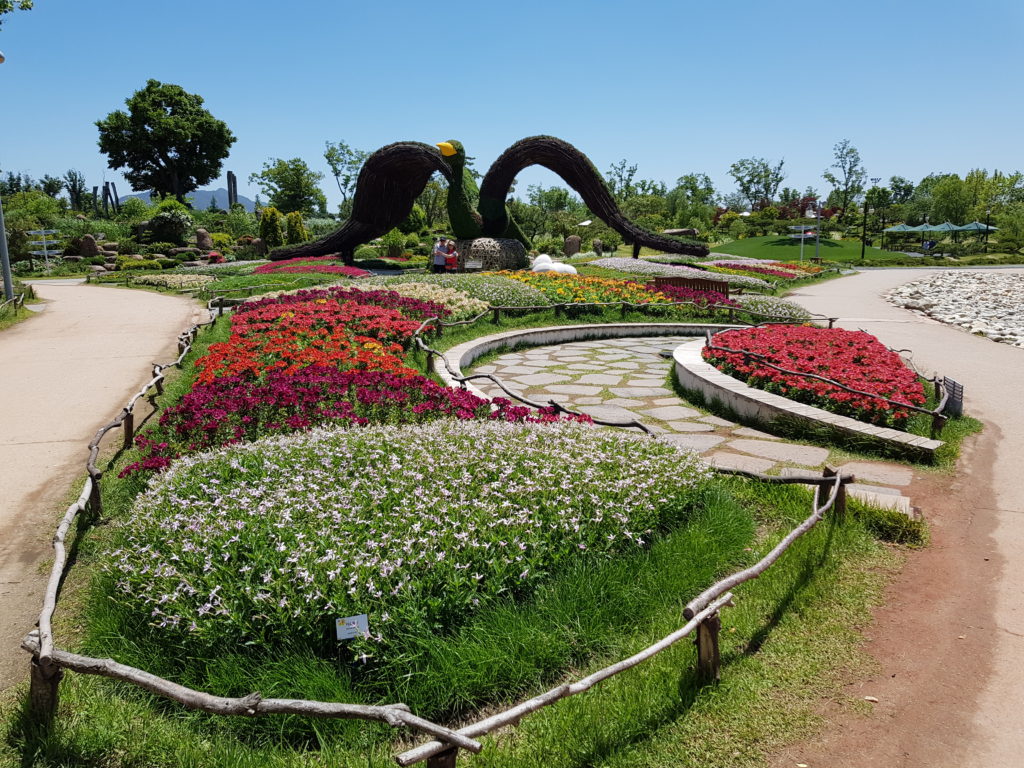
Drive to Gubongsan Observatory for a nice view over the industrial harbor and the northern part of Yeosu. You can drive all the way to the top, leaving only a few stairs to be climbed or park your car lower at a bigger parking lot to hike the last part.
On your way down make a quick stop at the stone tower and temple on your left side.
From there on drive to the Suncheon Bay National Garden. You can choose to park at the West or East gate, either is fine. The park itself is huge, featuring world gardens. You can walk for hours and still not see it all. It’s also a perfect place to bring a book and just read and relax in one of the many chairs, grass fields and so on. Every part offers a different seat.
Combine a visit to this garden with a visit to the Suncheon Wetland Reserve. I didn’t because I’d already visited wetlands in Gangneung (and my home country is pretty much all wetland), but if you don’t see wetlands every day this is definitely worth a visit. I might go there next time.
Where to stay in Gwangyang
I chose Hotel NOL (previously Hotel JAVA) in Gwangyang because I liked the idea of staying in a place that is less known among tourists and everything else (hotel availability and cost, location) matched what I was looking for. Next trip to that area I will be staying in a traditional house near Boseong. In Gwangyang there are many budget hotels to choose from (to compensate the earlier traditional house stay).
Where to eat in Gwangyang
I ate at three different restaurants in Gwangyang and liked them all very much.
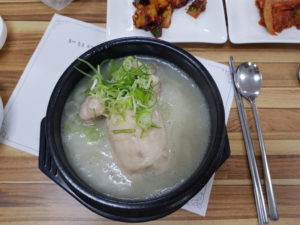
If you’re craving Chicken Ginseng, try Daebok Samgyetang,
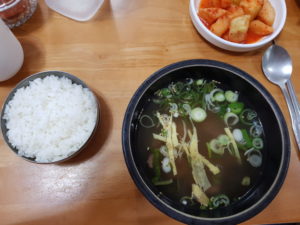
For beef bone soup (gomtang) go to 나주곰탕.
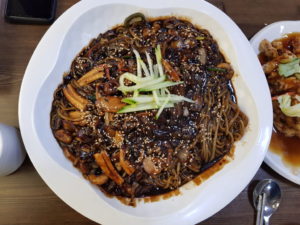
For Jjajangmyeon go to 햇찬 (it has a low score from two reviews, but this was the best jjajangmyeon I ate in my visits to South Korea plus they were opened at Whitsun, saving us from convenience store dinner).
Busan - day 16 - 18
Day 16 - Gwangyang to Busan - Tongyeong
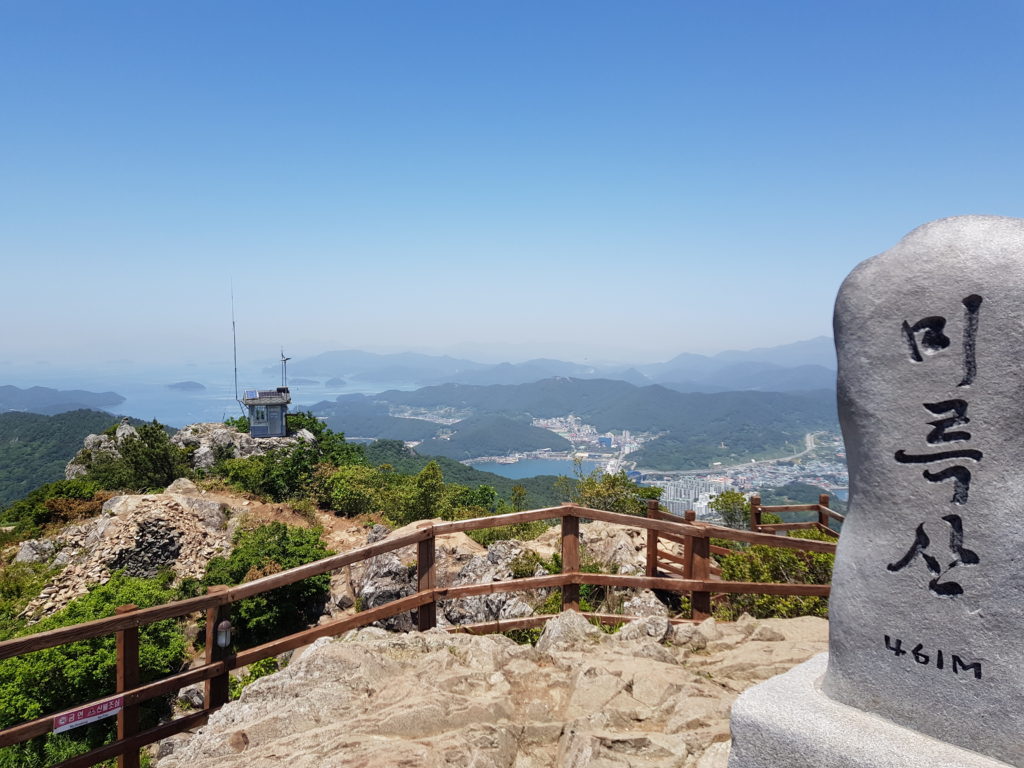
Visit Tongyeong and take Hallyeosudo Viewing Ropeway (one of the best in South Korea!) to the top to admire the view of the sea and many small islands. If the sky is clear you can see all the way to Japan. With a small hike (around half an hour) you can reach the summit of Mireuksan and get an even better view. Have lunch at the market in Tongyeong and take a stroll along Gangguan Port to see a full-size replica of a 16th-century wooden warship. Buy some Fresh Honey Baked Bread for a snack or souvenir.
When driving on to Busan from there admire the scenery and the many small islands.
After checking into your hotel in Busan go for dinner at Nampodong shopping street and Biff Square. Eat some Ssiat-heottok (Korean fried pancake stuffed with seeds) as dessert. Depending on the time of your arrival you can also visit Gukje market.
What to eat in Tongyeong
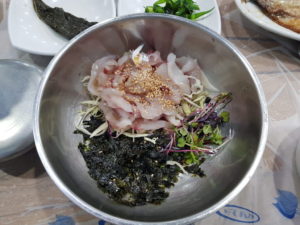
Seafood bibimbap at a restaurant in the harbor of Tongyeong
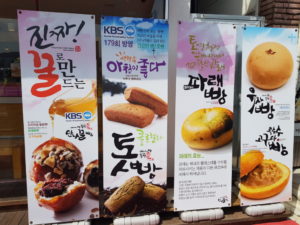
Buy some Fresh Honey Baked Bread to take with you.
Day 17 - Gyeongju
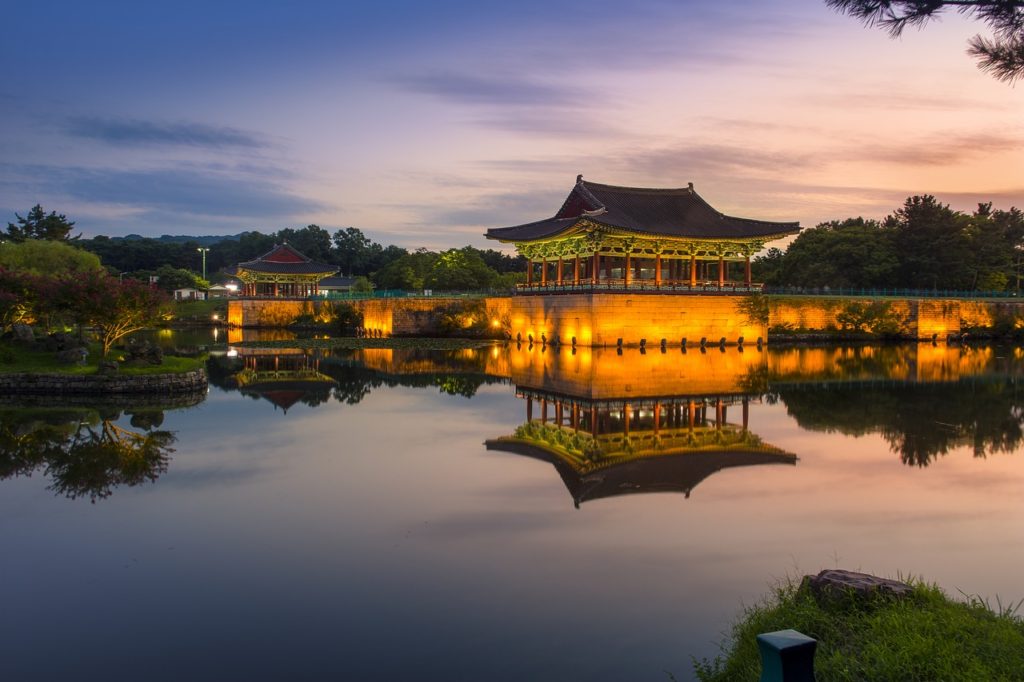
Gyeongju is often referred to as ‘the museum without walls’, due to the many archaeological sites in the area.
Start with a visit to Gyeongju’s Gyochon Traditional Village to observe some traditional houses. If you visit out of season (and in my case on a Tuesday) many restaurants and attractions will be closed but you can still wander through the streets and watch the hanok houses. Parking tip: park at the parking lot to the left of the village for free parking. You have to pay for parking spaces outside of the lot.
Next to the village, you can find Woljeonggyo Bridge, originally leading to Wolseong palace, a royal palace of the Silla dynasty.
Walk north from the Woljeonggyo Bridge towards Cheomseongdae Observatory, the oldest surviving star-gazing platform in Asia. On your way, you can see Gyeongju Hwangnamdong remains on the left side.
Northwest of Cheomseongdae Observatory, you can visit Daereungwon Tomb Complex to see the Tomb of King-Michu and Cheonmachong. Also interesting here hare the curved trees and fruit trees in the park.
East of Cheomseongdae Observatory you can visit Donggung Palace and Wolji Pond, the secondary palace used by the crown prince during the Silla period. During the Goryeo and Joseon period, the pond was referred to as Anapji Pond.
A fifteen minutes drive south of this historical site heavy area you can find Seochulji Pond, a site pretty much ignored by tourists and therefore blissfully quiet. The pond is at its best when the lotus flowers in the pond are in full bloom, but even if they are not the pond is worth a visit because of the lay of the land, the trees surrounding the pond and the buildings in the area.
If you have more time you can drive half an hour east to visit Bulguksa Temple and Seokguram Grotto.
Alternative option: stay in Busan and visit Busan Citizens Park or Peace Park and go shopping in one of the many malls and shopping areas. This is what I did last year, but on my next trip, I will be visiting Gyeongju and add more tips and information to this itinerary.
Day 18 - Gamcheon cultural village, Haeundae Beach
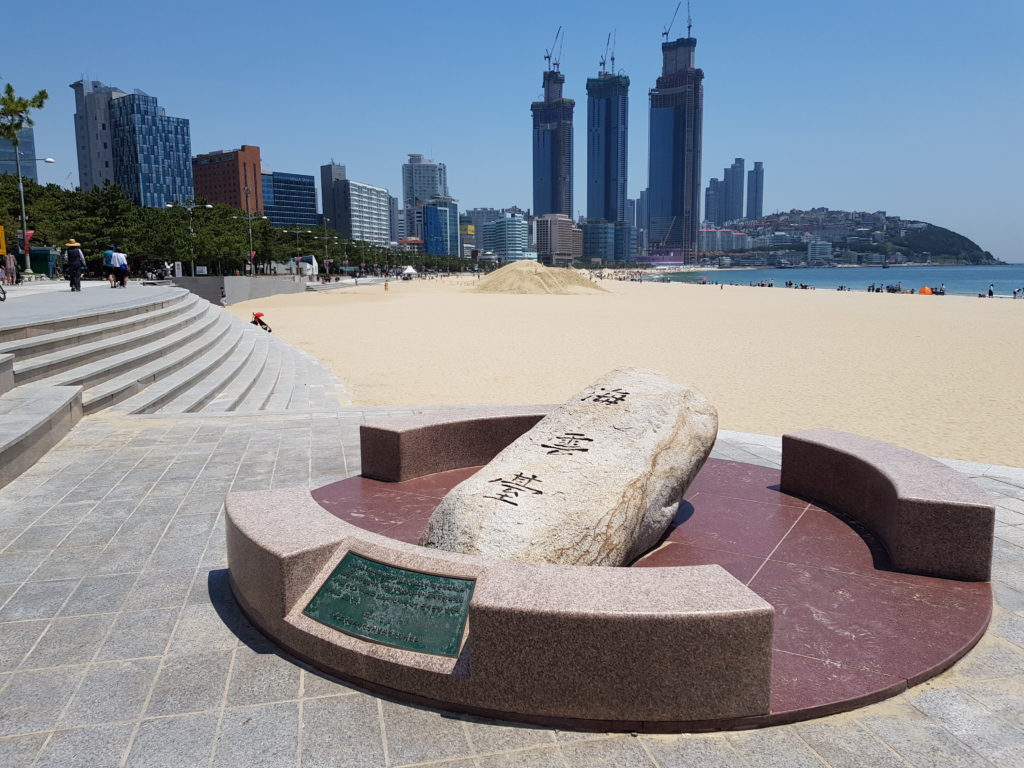
Visit Gamcheon cultural village in the morning. You can park your car in one of the parking garages nearby. There are some trails you can follow, but it is just as easy to just wander and still see it all. This colorful village is very photogenic so don’t forget to take many pictures.
After your visit to the village, you can either drive over to Haeundae Beach or leave the car at your hotel to take the subway to Haeundae Beach. It all depends on what you want to drink with your meal (and there can be quite a traffic jam in the late afternoon, so the subway is probably more convenient). The area around Haeundae beach has many Western restaurants, but do try the Eel street if you are still craving Korean food after eighteen days.
Where to stay in Busan
I very much enjoyed my stay at Hotel Elysee: the rooms were spacious and the staff was nice. The hotel is located near Nampodong, the train station and a subway station; a very convenient base for exploring the whole city. You can park your car in their garage.
Where to eat in Busan
What to read and watch in Busan
The beginning of Min Jin Lee’s Pachinko is set in Busan and an island below Busan. By reading this book you can get some insight into Busan during the Japanese occupation.
Blood sisters by Kim Yideum takes place in Busan and is one of the clearest recommendations I can give for this city. I really liked the writing style and the references to art, culture and philosophy. I enjoyed this book very much, but it might not be for everyone because of the subjects and thoughts in it.
If you like zombie movies, then definitely see Train to Busan. The main characters are trying to reach Busan to be safe from zombies.
Kim Yideum - Blood Sisters
Blood Sisters tells the story of Jeong Yeoul, a young Korean college student in the 1980’s, when the memory of President Chun Doohwan’s violent suppression of student demonstrations against martial law was still fresh. Yideum captures with raw honesty the sense of dread felt by many Korean women during this time as Jeong struggles in a swirl of misguided desires and hopelessness against a society distorted by competing ideologies, sexual violence, and cultural conservatism. Facing this helplessness, her impulse is to escape into the world of art. Blood Sisters is a vivid, powerful portrayal of a woman’s efforts to live an authentic life in the face of injustice.
Interested? Get your copy from Amazon.
Min Jin Lee - Pachinko
In the early 1900s, teenaged Sunja, the adored daughter of a crippled fisherman, falls for a wealthy stranger at the seashore near her home in Korea. He promises her the world, but when she discovers she is pregnant–and that her lover is married–she refuses to be bought. Instead, she accepts an offer of marriage from a gentle, sickly minister passing through on his way to Japan. But her decision to abandon her home, and to reject her son’s powerful father, sets off a dramatic saga that will echo down through the generations.
Interested? Get your copy from Amazon.
Train to Busan
Train to Busan is a harrowing zombie horror-thriller that follows a group of terrified passengers fighting their way through a countrywide viral outbreak, trapped on a suspicion-filled, blood-drenched bullet train ride to the Safe Zone…which may or may not still be there.
Interested? Watch it on Amazon Prime.
Jeju - day 19-21
Day 19 - Busan to Jeju - O'sulloc Tea Museum
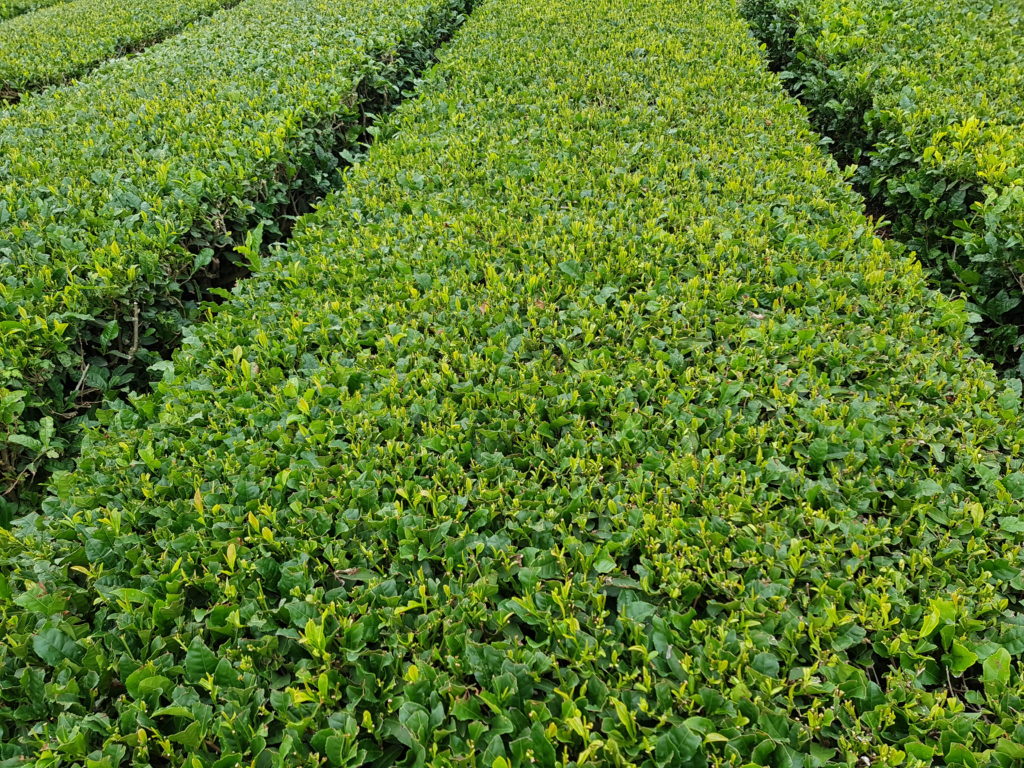
There are many flights from Busan to Jeju daily, so you can either choose to spend most of the day in Busan or head to Jeju early.
Drop the car off at Busan airport and enjoy the short flight. At Jeju airport, you can pick up your new car and drive over to O’sulloc Tea Museum (open until 7 pm) on the west side of Jeju. If you’re staying in Seogwipo or the western part of the island, this is a very good stop to make on the way to your hotel. However, if you booked a hotel in Jeju city, then explore the city instead and visit the Tea Museum some other time.
Day 20 - Hallasan
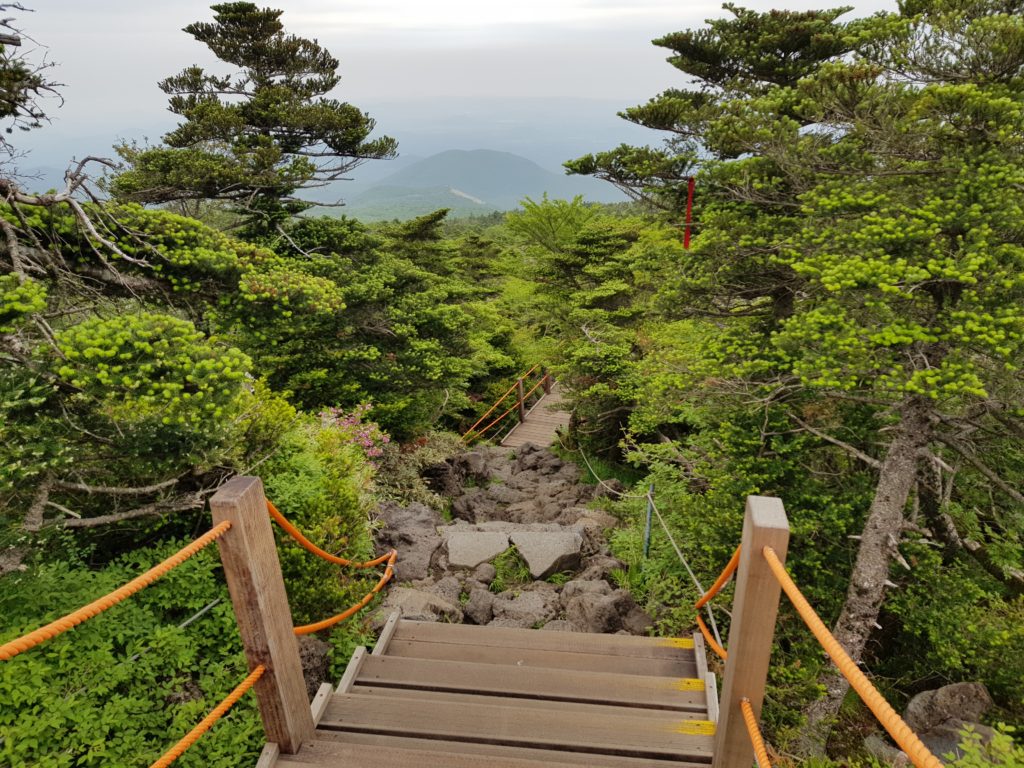
Hallasan is the highest mountain in South Korea and quite a challenge to hike. Imagine taking (uneven) stairs for more than three hours straight and then doing the same to go down. But if you make it to the top you are up for a nice view of the island. Plus it’s something you just have to do, right? Beat Hallasan. Try to do this on a clear day, if today is cloudy, do the activities for day 21 instead. If all days are cloudy then climbing Hallasan is still worth it because the area is beautiful enough on its own, even if you can’t see the whole island from the top.
Alternatively: go east and take a walk in Bijarim nutmeg Forest. From there on visit the Manjanggul Cave.
Day 21 - Seongsan Ilchulbong Peak, Oedalgae rock, Jusangjeolli Cliff
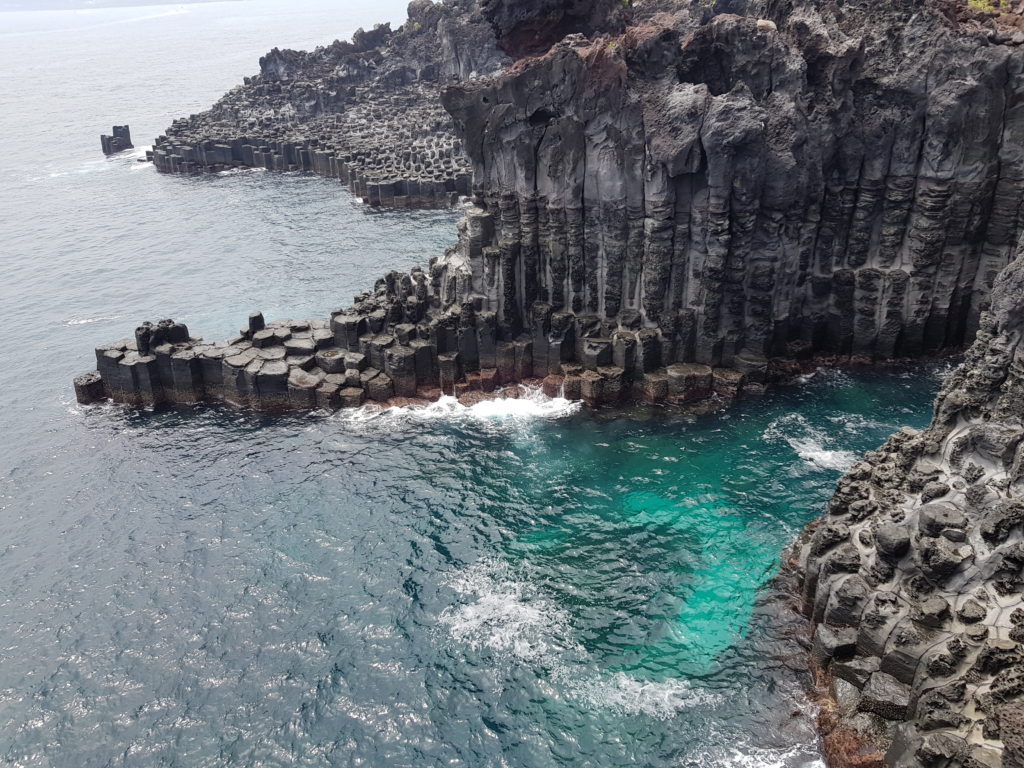
In the morning head to Seongsan Ilchulbong Peak in the east, also known as Sunrise Peak. Don’t worry about the sunrise part, it’s also beautiful later in the day. Make sure to also visit the female divers after your hike and if you can watch one of the demonstrations.
From there head west past Seogwipo to visit Oedalgae rock and take a walk along the coast.
Next up is Jusangjeolli Cliff, my favorite site on Jeju. The stone pillars of the coast are hexagonal shape and beautiful to see.
Fly home at the end of this day or the next day, depending on what’s most practical for you.
Where to stay in Jeju
You can stay anywhere on the island: everything is within driving distance. I chose Seogwipo because I found a hotel (Artstay Seogwipo Harbor) matching what I was looking for. It felt a bit cheap to me though as the breakfast was mediocre, the two elevators responded to the same button request causing long waiting times and it was really noisy (because of buses full of school kids). So I think you’ll enjoy your stay better at another hotel in Jeju.
What to read in Jeju
The Island of Sea Women by Lisa See is a must-read if you’re planning to visit Sunrise Peak and see the women divers of Jeju. It helps you understand more about their skills but also about their strength in providing for their families under dire circumstances. Set in Jeju during the Japanese occupation it shows you Jeju from the past, including its traditions and ways in which it is different from the mainland of South Korea. It is also very well written and easy to read.
Lisa See - The Island of Sea Women
The Island of Sea Women follows Mi-ja and Young-sook, two girls from very different backgrounds, as they begin working in the sea with their village’s all-female diving collective. Over many decades—through the Japanese colonialism of the 1930s and 1940s, World War II, the Korean War, and the era of cellphones and wet suits for the women divers—Mi-ja and Young-sook develop the closest of bonds. Nevertheless, their differences are impossible to ignore: Mi-ja is the daughter of a Japanese collaborator, forever marking her, and Young-sook was born into a long line of haenyeo and will inherit her mother’s position leading the divers. After hundreds of dives and years of friendship, forces outside their control will push their relationship to the breaking point.
Interested? Get your copy from Amazon.
The Curious Tale of Mandogi’s Ghost is an interesting tale set in Jeju (and Hokkaido, Japan for a few pages) showing the imprint the Japanese left on Korean memory. The story isn’t linear, making it hard to follow at times, and the language is perhaps a bit dated, but if you’re interested in the history of that period (1948) it gives some great insight into the thoughts of the people.
Kim Sok-Pom - The Curious Tale of Mandogi’s Ghost
“The Curious Tale of Mandogi’s Ghost” incorporates Korean folk tales, ghost stories, and myth into a phenomenal depiction of epic tragedy. Written by a “zainichi,” a permanent resident of Japan who is not of Japanese ancestry, the novel tells the story of Mandogi, a young priest living on the island of Jeju-do. Mandogi becomes unwittingly involved in the Four-Three Incident of 1948, in which the South Korean government brutally suppressed an armed peasant uprising and purged Jeju-do of communist sympathizers. Although Mandogi is sentenced to death for his part in the riot, he survives (in a sense) to take revenge on his enemies and fully commit himself to the resistance.
Interested? Get your copy from Amazon.
Read more about South Korea
- Visit the south and west of South Korea. Perfect for second-time visitors to South Korea.
- 13 Iconic and Funny Situations to Experience in South-Korea
Practical information
Time your Korea visit well
This journey is possible year-round but works best in spring and fall to avoid hot summers and cold winters (driving in the snow).
Tip: if possible, plan your arrival day on a Wednesday or Thursday for an optimal journey. This will help you avoid Jeju on the weekend when the island gets really crowded especially in the busy season. Also, keep in mind that many places like museums are closed on Mondays and/or Tuesdays. Avoid public holidays unless you specifically want to join the celebrations.
Transport and navigation
This itinerary uses a rental car to travel between cities and public transport within cities like Seoul and Busan. It is possible to do everything by public transport and cab if you skip some of the visit-while-traveling sights that are too time-consuming to get to without a car.
Navigating in South-Korea is easy. You can use Naver maps (Android / iOS) to find optimal driving and walking routes. When using a car navigation system, search for destinations by entering their telephone number (easy to find with google maps).
You can use either Naver or Google maps to calculate optimal public transport routes.
Estimated costs
The costs depend on your budget. If you choose to use mid-range hotels your journey will be more expensive than when you stay in hostels. Likewise, if you rent a car it matters if you are a solo traveler bearing the costs alone (but lower total costs because the car can be smaller) or travel with family or friends and can share the costs. You can eat in expensive restaurants every day or buy some cup ramyun in a convenience store. Eating out in South Korea is not expensive, but certain meals are, like when you want to eat prime quality abalone or samgyeopsal (pork belly).
The costs listed below are based on comfort, but not too luxurious. By choosing cheaper hotels or motels (still with a private room and personal bathroom) in cities and more expensive traditional houses in rural areas you can adjust the costs as you like and still keep low affordable costs per night average.
Transport
- Retour flight from your hometown to Seoul and from Jeju to your hometown: costs depend on where you live
- Flight from Busan to Jeju: from 50 euro (55 USD) per person
- Hiring a car for the mainland (16 days), picking it up on Day 4 in Seoul and dropping it off on Day 19 in Busan: around 1200 euro (1318 USD) for a mid-range car (for 3-4 persons), including a one-way fee. This will be cheaper if you travel alone because you can rent a smaller car.
- Hiring a car on Jeju (4 days), mid-range car for 3-4 person: 120 euro (132 USD) in total. This will be cheaper if you travel alone because you can rent a smaller car.
- Gasoline: around 150 euro (165 USD) in total
- Public transport: buying a public transport card and loading it with fare: 20 euro (22 USD) per person
Food
- Around 30 euro daily per person for 21 days: 630 euro (692 USD) per person
Accommodation
- Around 40 euro daily per person for 21 days based on mid-range hotels: 820 euro (900 USD) per person
Wifi
- 43 euro (47 USD) in total for 21 days. I always order via Klook.com as they offer the cheapest pocket wifi in can find for many Asian countries.
Souvenirs
- As much or as little as you want
Keep in mind that this is just an estimation based on the trip I did in May 2018. It cost me around 1920 euro (2109 USD) in total, excluding intercontinental flights. If you do this trip on a budget (cheaper hotels, food, flights and a smaller car) the total cost will be much lower.
Pin it for later
